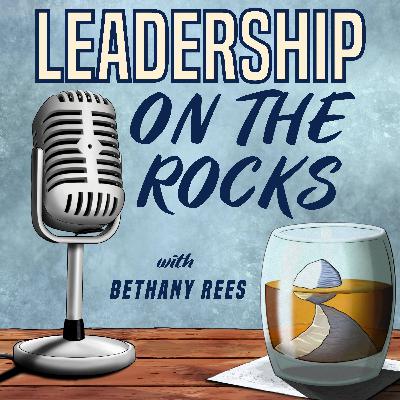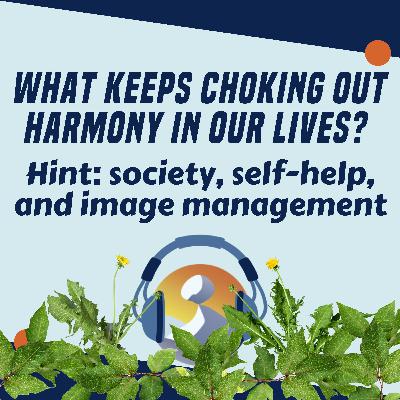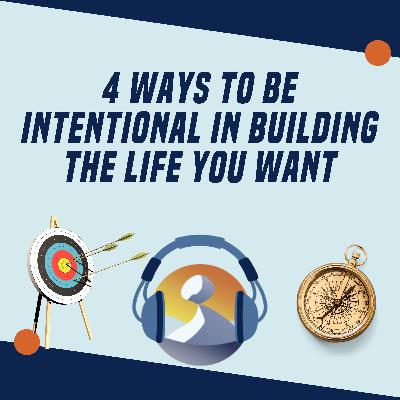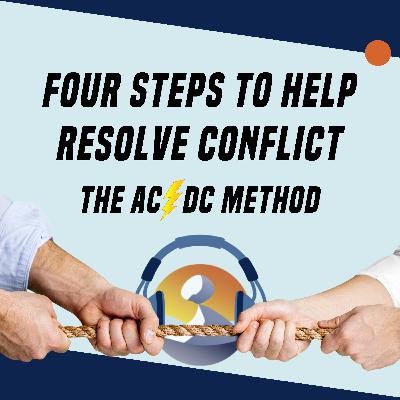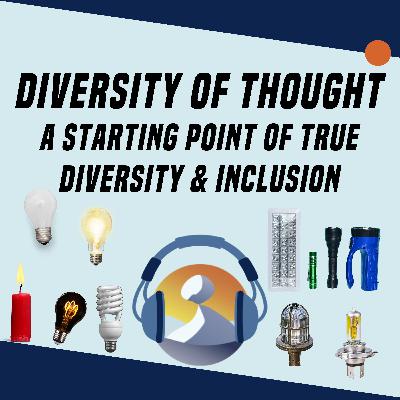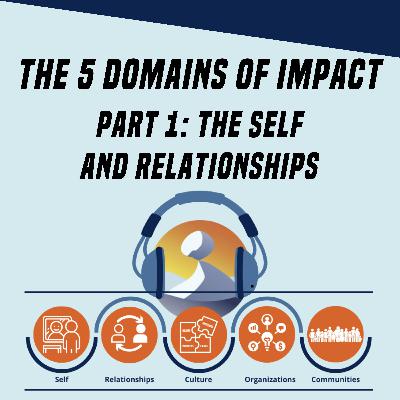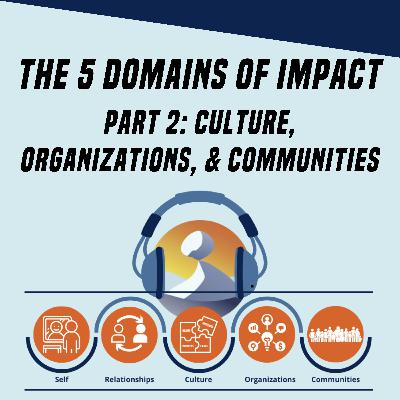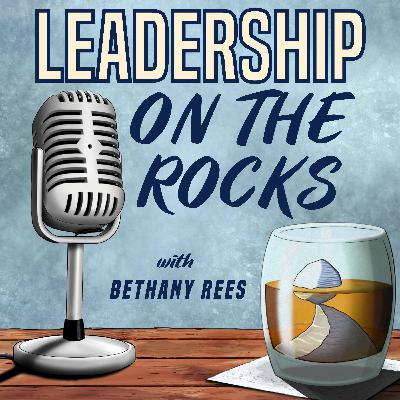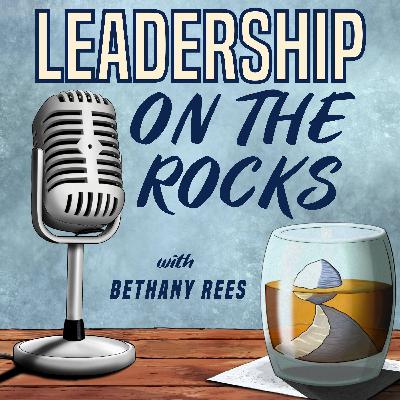Discover Leadership on the Rocks
Leadership on the Rocks

Leadership on the Rocks
Author: Bethany Rees
Subscribed: 4Played: 57Subscribe
Share
© 2025 Leadership on the Rocks from BR Essential Services
Description
The Leadership on the Rocks podcast is about equipping and empowering leaders like you, so you can THRIVE IN and CREATE HARMONY BETWEEN YOUR PROFESSIONAL AND PERSONAL LIVES. As a community through this podcast, we will become equipped with the essential leadership skills needed to grow professionally, but understand that it doesn't have to come at the expense of our home and family lives. Together, we will share struggles and lessons learned as well as look to leadership principles and best practices for being our best at work and at home. Visit us at www.leadershipontherocks.com for more FREE resources as well as online courses, coaching, workshops, and speaking.
102 Episodes
Reverse
The Leadership on the Rocks podcast was made for leaders like you who want to grow professionally, but not at the expense of your home and family life.
Whether it’s your family, a team, or an entire organization, you don’t want to be a manager of status quo that keeps your family, your employees, and yourself living and working in survival mode.
As a community through this podcast, you will become equipped with the essential leadership skills needed to not only thrive in but to create harmony between your professional and personal lives.
So go grab your favorite drink on the rocks, subscribe to the Leadership on the Rocks podcast, and tune in weekly for new episodes. To all of you essential leaders out there leading your families, teams, and organizations…Cheers!
Bethany(wife, mom, educator, entrepreneur, and CEO)
Start overcoming overwhelm TODAY and join the waitlist for the Leadership On The Rocks: The Survival Guide Course,
CONTACT US:
Visit our website at https://www.leadershipontherocks.com/
Follow us online at:
Facebook: Leadership on the Rocks
Instagram: @leadership_onthe_rocks
Linked In: Bethany Rees
Twitter: @Leadontherocks
Email us at contact@bressentialservices.com
Start overcoming overwhelm TODAY and join the waitlist for the Leadership On The Rocks: The Survival Guide Course,
CONTACT US:
Visit our website at https://www.leadershipontherocks.com/
Follow us online at:
Facebook: Leadership on the Rocks
Instagram: @leadership_onthe_rocks
Linked In: Bethany Rees
Twitter: @Leadontherocks
Email us at contact@bressentialservices.com
As leaders we are drowning ourselves in guilt, stress, and anxiety because we are unable to meet all the demands of work and our responsibilities at home. In this episode we will learn how to move our lives and our leadership to higher ground so we stop drowning and start flourishing.
All content shared will be based on personal experiences, audience experiences, and the gurus in leadership and family.
Some of the resources discussed today were:
The Bible - https://www.youversion.com/the-bible-app/
7 Habits of Highly Effective People by Stephen R. Covey
5 Dysfunctions of a Team and The Three Big Questions for a Frantic Family by Patrick Lencioni
John Maxwell (he has written a ton of leadership books)
Essentialism and Effortless by Greg McKeown
Start with Why by Simon Sinek
Start overcoming overwhelm TODAY and join the waitlist for the Leadership On The Rocks: The Survival Guide Course,
CONTACT US:
Visit our website at https://www.leadershipontherocks.com/
Follow us online at:
Facebook: Leadership on the Rocks
Instagram: @leadership_onthe_rocks
Linked In: Bethany Rees
Twitter: @Leadontherocks
Email us at contact@bressentialservices.com
Warning: Without listening to and internalizing today’s podcast, all the amazing help the other episodes will give us will be for naught. Why? Because to truly grow into a better leader, spouse, parent, family member, or friend, we have to pull back the curtains on how we engage with the world and realize that “we ain’t all that plus a bag of chips.” If we don’t start with understanding ourselves and how we how see the world and think about the experiences we have then we will continue to trick ourselves into believing that the world revolves around us and our point of view.
Summary: How we see the world (our paradigm) and how we think about it (our mindset) has everything to do with how we experience life…and yours? Well, yours just might be getting in your way from finding joy and contentment at work and at home.
Our paradigm is the way we “see” the world, or our frame of reference for how we interpret situations, people, and the world in general. Depending on how our paradigms are "tilted" or the assumptions we have been conditioned to, we can all have very different paradigms for how we see the world and the people in it.
Mindset is the way your mind is set to think about things. Somewhere along the way our thinking led us to a story, and that story has caused deep ruts in our roads of thinking. And the thing is, we’ve been listening to stories and telling ourselves stories our whole lives. We become stuck in how we think about ourselves or the world around us; which in turn affects how we think about many other things we experience. There are four popular "settings" for mindset:
Fixed vs Growth (Reference Carol Dweck, P.h.D)
Scarcity vs Abundance (Reference Stephen R. Covey)
Application
You can't change other people so all positive change must start with you and you alone. Focus on self awareness so you come to understand how the obstacles you are currently facing affects your overall motivations, beliefs, thoughts, communication, and actions in overcoming those obstacles. The more you recognize and reflect on your "seeing and thinking" habits and the stories you tell yourself, you can become more able to slow your thinking and adjust the settings.
When it comes to paradigm and building assumptions, you need to always be looking for clarity by seeking to understand the other person’s point of view. You must understand that your paradigm is not always right. Now when it comes to mindset, you need to slow your thinking, stop the spiral of thoughts, and adjust your settings. You can in fact turn the mindset dial to that of growth and abundance.
References:
Covey, S. R. (1989). The Seven Habits of Highly Effective People: Restoring the character ethic. New York: Simon and Schuster.
Klein, Gary (May 1, 2016). Mindsets: What They Are and Why They Matter. Psychology Today. https://www.psychologytoday.com/us/blog/seeing-what-others-dont/201605/mindsets
Dweck, Carol (2006). Mindset: The new psychology of success. New York: Random House.
Soul Sisters Memorial Foundation Facebook Post on January 30, 2022 at 9:31 am "When you finally learn that a person's behavior has more to do with their internal struggle than it ever did with you, you learn grace. (Vintage Vivids)
The Holy Bible, English Standard Version. ESV® Text Edition: 2016. Copyright © 2001 by Crossway Bibles, a publishing ministry of Good News Publishers. https://www.biblegateway.com/passage/?search=james+1%3A2-4&version=ESV
Start overcoming overwhelm TODAY and join the waitlist for the Leadership On The Rocks: The Survival Guide Course,
CONTACT US:
Visit our website at https://www.leadershipontherocks.com/
Follow us online at:
Facebook: Leadership on the Rocks
Instagram: @leadership_onthe_rocks
Linked In: Bethany Rees
Twitter: @Leadontherocks
Email us at contact@bressentialservices.com
Summary:
Being in charge and leading are two completely different things. At work, a person can be in charge but not lead at all. At home, sometimes we allow our kids and their schedules to be in charge…but that definitely isn’t leadership either. In today’s episode we will discuss what leadership really is and how to step into true leadership at work and at home.
Managing is more about tasks, checklists, systems, and processes. It focuses on keeping the status quo. Leading, however, is all about people. Leadership is influencing people and as John Maxwell says in his book The 21 Irrefutable Laws of Leadership, “everything rises and falls on leadership.”
Managers are like the Pharisees in the bible, all about the rules and tradition over relationships with the people. Leaders are like Jesus, focused on serving, teaching, and showing people the way to a better life.
In today’s episode we reflect on our own leadership ability in 5 basic but very important leadership areas: people skills, vision, planning and strategic thinking, accountability, and achieving results. We then talk through four scenarios (2 at work and 2 at home) about having a lack of leadership and what to do about it.
Application
People are held to the leadership ability lid (See Maxwell, 2007) of others and it causes great frustration at work and at home. If you are in a situation where you work for a manager and not a leader or your leader has a very low leadership ability lid, then it is time for you to have a crucial conversation to help solve the problem via a win/win plan of action. If you are the leader that is struggling then there is hope for you, work to grow your leadership ability lid.
Concerning home life, does your house/family have true leadership and structure to thrive? If not, chances are you are allowing your children to run the home (laissez-faire, lawnmower, helicopter parent) or you are running the home with an iron fist (totalitarian). Neither of those exhibit true leadership. Work to grow your leadership skills at home just like you would at work…focus on the people in your household and provide structure, instruction, and discipline…and balance it all with love and encouragement.
References:
Maxwell, John (2007). The 21 Irrefutable Laws of Leadership. USA: HarperCollins Leadership, pg 7 & 267.
Gerber, Michael E. (1995) The E Myth: Revisited. New York: HarperCollins
Patterson, Grenny, Maxfield, McMillian, Switzler. Crucial Accountability. New York: McGraw-Hill Education, 2013. Print.
The Holy Bible, English Standard Version. ESV® Text Edition: 2016. Copyright © 2001 by Crossway Bibles, a publishing ministry of Good News Publishers. https://www.biblegateway.com/
Let us help you become an Essential Leader of Impact. Schedule a Call with us today to share the biggest problems in leadership so we can help you overcome the overwhelm.
Provide clarity for your employees, by getting your FREE High Will / High Skill Chart here.
Stop hosting meetings that suck, by getting your FREE Meeting Agenda here.
Start overcoming overwhelm TODAY and join the waitlist for the Leadership On The Rocks: The Survival Guide Course,
CONTACT US:
Visit our website at https://www.leadershipontherocks.com/
Follow us online at:
Facebook: Leadership on the Rocks
Instagram: @leadership_onthe_rocks
Linked In: Bethany Rees
Twitter: @Leadontherocks
Email us at contact@bressentialservices.com
Summary:
No matter your breadth of leadership influence it is important to know that there are a few challenges all leaders experience. Whether you are new to leadership or have been a leader for decades, one thing is for sure, you will always experience challenges such as:
The 1st challenge every leader experiences is the challenge of time constraints - everyone on this planet only has 24 hours to get the job done and we probably all needed that “thing” done yesterday. That includes billionaires like Mark Cuban and Warren Buffet, and CEO’s like Tim Cook from Apple and Andy Jassy from Amazon. Whether it’s a billionaire, CEO, or piddly little oh me…we all have 24 hours in day.
A 2nd challenge every leader experiences is leading through the unknown - everyone goes through situations where they just don’t have all the answers. It doesn’t matter whether you're a first time parent not knowing how to care for a crying baby or a leader in a service-based industry trying to save people’s jobs through a social distancing pandemic. Life is hard and curveballs are thrown all the time…all leaders are challenged with leading through the unknown.
A 3rd challenge every leader experiences is conflict - everyone experiences conflict - whether it is conflict in a marriage, within their team, between their stakeholders, or with public opinion …. Every leader has to work to bring common goals and unity to the forefront to restore the relationship and move forward.
Application:
Even though all leaders face challenges we can walk with humble confidence in our leadership. Humility is not about thinking less of yourself but thinking of yourself less…humility is other people focused. And guess what…leadership is people focused. Now confidence is not the same thing as arrogance. Confidence is trust and belief in something and it can be found in multiple things. Like having confidence in God for provision and protection, confidence in the people you work with to come together in unity to solve a problem, and yes you can have confidence in yourself to do your job and lead.
Here are 4 ways to build humble confidence as you lead through challenging situations:
First, You must Have complete and total dependence on God.
Second, you have to stop making everything about you.
Third, you need to recognize that there is no perfect plan or checklist but that wisdom comes from God first, not man.
Fourth, you need to know that almost all problems are mole hills, not mountains.
References:
Blanchard, Ken, et. al. Lead Like Jesus Revisited. Nashville: W Publishing, 2016.
The Holy Bible, English Standard Version. ESV® Text Edition: 2016. Copyright © 2001 by Crossway Bibles, a publishing ministry of Good News Publishers. https://www.biblegateway.com/passage/?search=james+1%3A2-4&version=ESV
Holy Bible, New Living Translation, copyright © 1996, 2004, 2015 by Tyndale House Foundation. Used by permission of Tyndale House Publishers, Inc., Carol Stream, Illinois 60188. All rights reserved.
Holy Bible, New International Version®, NIV® Copyright ©1973, 1978, 1984, 2011 by Biblica, Inc.® Used by permission. All rights reserved worldwide.
Start overcoming overwhelm TODAY and join the waitlist for the Leadership On The Rocks: The Survival Guide Course,
CONTACT US:
Visit our website at https://www.leadershipontherocks.com/
Follow us online at:
Facebook: Leadership on the Rocks
Instagram: @leadership_onthe_rocks
Linked In: Bethany Rees
Twitter: @Leadontherocks
Email us at contact@bressentialservices.com
Summary:
Since the invasion of Ukraine there have been two types of leadership that have been on display for the world; that of Ukrainian President Volodymyr Zelensky and that of Russian President Vladimir Putin. Their leadership styles during the invasion are polar opposite and easily showcased in four different areas:
Power and Influence
Relationships
Communication
Position
This podcast does not go into detail about the day to day leadership of either leader but solely focuses on how each president is displaying two different types of leadership during the invasion.
Application:
As leaders it is important to not only reflect on our own leadership, but leadership being displayed by other leaders. Even though you may never experience having to lead through an invasion you can learn from how each leader used their power, built relationships and communicated with their people, and led from different positions during the conflict.
Resources:
Understanding Fallacies
LSU explains Ethos, Pathos, & Logos
References:
Godin, Seth. This is Marketing. Italy: Portfolio/Penguin, 2018.
Emotional Intelligence. Psychology Today. https://www.psychologytoday.com/us/basics/emotional-intelligence
Emotional Intelligence in Leadership. Mind Tools. https://www.mindtools.com/pages/article/newLDR_45.html
Lister, Tim, et. al. CNN.com. “Here’s what we know about how Russia’s invasion of Ukraine unfolded. Posted February 24, 2022. https://www.cnn.com/2022/02/24/europe/ukraine-russia-attack-timeline-intl/index.html
Andy Stanley listen quote https://twitter.com/andystanley/status/1428471840603885577
The Holy Bible, English Standard Version. ESV® Text Edition: 2016. Copyright © 2001 by Crossway Bibles, a publishing ministry of Good News Publishers. https://www.biblegateway.com/passage/?search=james+1%3A2-4&version=ESV
Start overcoming overwhelm TODAY and join the waitlist for the Leadership On The Rocks: The Survival Guide Course,
CONTACT US:
Visit our website at https://www.leadershipontherocks.com/
Follow us online at:
Facebook: Leadership on the Rocks
Instagram: @leadership_onthe_rocks
Linked In: Bethany Rees
Twitter: @Leadontherocks
Email us at contact@bressentialservices.com
Summary:
Many Americans have reached such a high point of busyness, anxiety, or stress that they struggle to make it through each day mentally. This is causing not only a mental health crisis but an economic crisis as many people suffering from burnout choose to resign from their place of employment.
Enter the Great Resignation.
Whether you are experiencing the pain of the Great Resignation as the boss that hires or as the employee that is ready to leave, in today’s podcast we’ll discuss four causes of burnout at work and how to extinguish burnout in order to rekindle passion and purpose within our work…not only for you but those that work with and for you.
Application:
Root Cause #1 - Having Unmet Expectations
Solution #1 - The solution is to have candid conversations with the stakeholders involved so those expectations are verbalized. Then work towards meeting the expectations you have power over, ask about those that require up the ladder approval, and explain and/or simplify those that you have no control over. It is absolutely amazing what just having an honest and vulnerable conversation will do for the mind and heart of a person.
Root Cause #2 - A Negative Work Culture
Solution #2 - If you are boss, then you need to assess how bad the current culture is as well as reflect on whether or not you’ve even provided clarity on the core values and beliefs your team should have and rally around. If there is no target for what a positive culture looks like in your organization, then how are you and your people going to work towards it? If you have no target for what a positive culture looks like, work with your employees to create one. If you have one but nobody works towards it, then you my friend have an accountability problem…and it’s all your fault.
Root Cause #3 - A Lack of Clarity about What is Most Essential
Solution #3 - To avoid burnout among our employees, our places of employment have to do a better job of providing clarity on what is essential, or the most important priorities. Focus on the right thing at the right time for the right reason.
Root Cause #4 - A Lack of Leadership Support
Solution #4 - As leaders we need to shield our people from unnecessary stresses or demands of their time and attention while supporting and nourishing their growth and development. (Any easy example is stop hosting meetings that waste everyone’s time and cost the company a ton of money and resources because there is no return on investment from it.)
References:
Milenkovic, Milja. “42 Worrying Workplace STRESS Statistics.” The American Institute of Stress, 25 Sept. 2019, www.stress.org/42-worrying-workplace-stress-statistics.
"Bureau of Labor Statistics, U.S. Department of Labor, Occupational Outlook Handbook, Job Openings and Labor Turnover - November 20121, on the Internet at https://www.bls.gov/news.release/pdf/jolts.pdf (visited January 31, 2021)."
Cook, Ian. "Who is Driving the Great Resignation?" Harvard Business Review, 15 September 2021, https://hbr.org/2021/09/who-is-driving-the-great-resignation.
Chinni, Dante. "Great Resignation' hits schools across all positions," NBC News online, 26 December 2021, https://www.nbcnews.com/meet-the-press/news/great-resignation-hits-schools-across-all-positions-n1286565
McKeown, Greg. (2014). Essentialism. USA: Crown Business.
McKeown, Greg. (2021). Effortless. USA: Random House.
Brown, Brene. (2017). Braving the Wilderness. New York: Random House.
Brown, Brene. (2018). Dare to Lead. New York: Random House.
The Holy Bible, English Standard Version. ESV® Text Edition: 2016. Copyright © 2001 by Crossway Bibles, a publishing ministry of Good News Publishers. https://www.biblegateway.com/
Start overcoming overwhelm TODAY and join the waitlist for the Leadership On The Rocks: The Survival Guide Course,
CONTACT US:
Visit our website at https://www.leadershipontherocks.com/
Follow us online at:
Facebook: Leadership on the Rocks
Instagram: @leadership_onthe_rocks
Linked In: Bethany Rees
Twitter: @Leadontherocks
Email us at contact@bressentialservices.com
Summary:
Leaders it is imperative to understand that positive change always has to start with the self. And my self, your self, and our selves, have a boundary problem.
We are caught up in performance based affirmation and validation and don’t have healthy boundaries in life. We don’t have Healthy boundaries with
The pressures of society because we easily give up our individual thoughts and priorities to be able to conform to the current patterns or trends.
We don’t have healthy boundaries with the promises of the self-help genre because it’s marketing is blinding us to our need for God.
And we don’t have healthy boundaries with other people because of image management.
Yep… if our lives were a garden, we are allowing other weeds to take over and choke out the priorities we planted. All because we don’t have healthy enough boundaries to stop the invasion.
Application:
But now we know how to grow healthy boundaries and dig up those invasive weeds choking the life out of us.
The pressures from the patterns and trends of society are choking out our individual thoughts and patterns. But no more, …we will stop looking left and looking right in comparing ourselves to others and conforming to group think. We instead will look up. Stepping into who God made us to be and we will speak out and stand up for our thoughts and priorities.
The promise of the perfect plan are choking out our true source for harmony in the chaos which is God. But no more,...we will stop looking for the perfect plan and checklist and instead be in intentional and be present in our most important relationships.
The poison of image management is choking out our healthy relationships with others. But no more,...we will stop carrying the weight of others expectations and stop applying the pressure for others to be like us.
Remember that as leaders, positive change always starts with us and well, we need healthier boundaries so our leadership garden can grow and flourish without the weeds.
References:
Wright, Christy. (2021). Take Back Your Time. Franklin, TN: Ramsey Press.
Fletcher, Patti (November 13, 2020). Work-Life Balance Is Over: Let’s Talk About Work-Life Harmony. Forbes.com. https://www.forbes.com/sites/forbeshumanresourcescouncil/2020/11/13/work-life-balance-is-over-lets-talk-about-work-life-harmony/?sh=269ea8125b48
“What Does a Boundary Look Like?.” Boundaries, by Dr. Henry Cloud & Dr. John Townsend, Zondervan, 2017, pp. 32, 43-44.
LaRosa, John. (August 2, 2021). $10.4 Billion Self-Improvement Market Pivots to Virtual Delivery During the Pandemic. Market Research.com https://blog.marketresearch.com/10.4-billion-self-improvement-market-pivots-to-virtual-delivery-during-the-pandemic
Labyrinth. Directed by Jim Hensen, performances by David Bowie, Jennifer Connelly, Tri-Star Pictures, 1986.
Godin, Seth. The Practice. New York: Portfolio, 2020. Print.
Hodde Miller, Sharon (2017). Free of Me: Why Life is Better When It’s NOT ABOUT YOU. Grand Rapids, Michigan: Baker Books.
The Holy Bible, English Standard Version. ESV® Text Edition: 2016. Copyright © 2001 by Crossway Bibles, a publishing ministry of Good News Publishers. https://www.biblegateway.com
Start overcoming overwhelm TODAY and join the waitlist for the Leadership On The Rocks: The Survival Guide Course,
CONTACT US:
Visit our website at https://www.leadershipontherocks.com/
Follow us online at:
Facebook: Leadership on the Rocks
Instagram: @leadership_onthe_rocks
Linked In: Bethany Rees
Twitter: @Leadontherocks
Email us at contact@bressentialservices.com
Summary & Application:
Today we discussed how most people and yes even leaders are being passive in their lives.
Most people just live your life by accident as victims of every circumstance that happens to them. But no more for us in the Leadership on the Rocks community…We will be active participants in leading, planning, and living into our purpose for our lives. We will be intentional in living the life we are meant to live not only as an individual, but as a leader in our family and at our place of work.
The 4 ways we are going to live, work, and lead intentionally so we build the life we actually want to live is by
1) Having a Clear Mission - We will find our God-given purpose in life and know what our higher purpose is within our families and work.
2) Develop Clear working boundaries - We will run our calendar and our emotions and not let them run us. We will make time to work “on” our lives or the business instead of always being caught up in the sand elements of them.
3)Develop Clear vision - Dreaming of what our version of the future looks like when we live our mission
4) Determine and prioritize our Values - Deciding what principles will drive our behavior and therefore the outcomes (See an example at www.bressentialservices.com/site/about).
References:
Gerber, Michael. The E Myth Revisited. New York: Harper Collins, 1995.
Blanchard, Ken, et. al. Lead Like Jesus Revisited. Nashville: W Publishing, 2016.
Lencioni, Patrick. The 3 Big Questions for a Frantic Family. San Francisco: Jossey-Bass, 2008.
Holy Bible, King James Version. Public Domain
Start overcoming overwhelm TODAY and join the waitlist for the Leadership On The Rocks: The Survival Guide Course,
CONTACT US:
Visit our website at https://www.leadershipontherocks.com/
Follow us online at:
Facebook: Leadership on the Rocks
Instagram: @leadership_onthe_rocks
Linked In: Bethany Rees
Twitter: @Leadontherocks
Email us at contact@bressentialservices.com
Summary:
As a leader, people are your greatest asset but they can also be your biggest headache…enter conflict. Where there are people there will be conflict. Why? Because you didn’t hire people, or marry someone for that matter, who thinks like and acts just like you. The result of these differences can lead to conflict. Conflict of beliefs, values, opinions, and behaviors.
As a leader though, it is your job to step into the hard conversations to resolve conflict and model skills of how to have problem-solving dialogue. Today we will discuss the AC/DC method to resolving conflict in order to find not only resolution, but reconciliation and a clear path forward.
Application:
Proactive Solution - Blog Post on 5 Ways to Foster Healthy Relationships with Everyone
Post Incident Solution -
Accept - Accept the fact that you must have the difficult conversation
Check - Check your ego
Decide - Decide what the actual problem is (one time situation/behavior, or pattern)
Converse - Have Dialogue that Goes for the Win-Win
References:
Sly & The Family Stone. Everyday People (Official Video). https://www.youtube.com/watch?v=YUUhDoCx8zc
Patterson, Grenny, Maxfield, McMillian, Switzler. Crucial Accountability. New York: McGraw-Hill Education, 2013. Print.
Patterson, Grenny, McMillan, Switzler. Crucial Conversations. New York: McGraw-Hill Education, 2012. Print.
The Holy Bible, English Standard Version. ESV® Text Edition: 2016. Copyright © 2001 by Crossway Bibles, a publishing ministry of Good News Publishers.
Stop hosting meetings that suck, by getting your FREE Meeting Agenda here.
Start overcoming overwhelm TODAY and join the waitlist for the Leadership On The Rocks: The Survival Guide Course,
CONTACT US:
Visit our website at https://www.leadershipontherocks.com/
Follow us online at:
Facebook: Leadership on the Rocks
Instagram: @leadership_onthe_rocks
Linked In: Bethany Rees
Twitter: @Leadontherocks
Email us at contact@bressentialservices.com
Summary:
“This meeting was a waste of my time and energy,” said every employee ever about most meetings ever. The truth is most of your meetings suck. They suck away our time. They suck our energy. They suck our morale. They suck our productivity, and they suck our results and profits. Yes…Your bad meetings are sucking the life out of your employees and your company.
Hosting an effective meeting isn’t rocket science…honestly it just takes an ounce of intentionality in focusing on what is most essential.
There’s generally three areas you need to think through in planning a meeting
Purpose & Outcome
Organization
Efficiency
Application:
CLICK HERE for your FREE agenda template
WHY - Why do you need to call a meeting in the first place? The 3+ WHYs behind calling a meeting:
Team building
Aligning day to day work with the company mission or team goals
Professional growth
And the trifecta of meetings might have all three involved.
WHO - Who needs to be present in order for your WHY to be fulfilled?
WHAT - What exactly needs to be shared, discussed, decided on?
HOW - What format will you use to make your meeting efficient?
WHEN - When and how long does your meeting need to be? (It will fill whatever space it is scheduled.)
WHERE - Should the meeting be in person or virtual?
References:
Lencioni, Patrick. The Five Dysfunctions of a Team. San Francisco: Jossey-Bass, 2002.
Hyatt, Michael. Twitter quote. May 21, 2021. https://twitter.com/michaelhyatt/status/1395787165234352130
Hyatt, Michael. No Fail Meetings and Full Focus Resources
The Holy Bible, English Standard Version. ESV® Text Edition: 2016. Copyright © 2001 by Crossway Bibles, a publishing ministry of Good News Publishers.
Start overcoming overwhelm TODAY and join the waitlist for the Leadership On The Rocks: The Survival Guide Course,
CONTACT US:
Visit our website at https://www.leadershipontherocks.com/
Follow us online at:
Facebook: Leadership on the Rocks
Instagram: @leadership_onthe_rocks
Linked In: Bethany Rees
Twitter: @Leadontherocks
Email us at contact@bressentialservices.com
Summary:
Diversity and Inclusion are popular goals and strategies being talked about in various organizations and we all use the words like we know what all it encompasses, but I don’t think people in general truly understand the concepts nor how to live them out.
Diversity in the workplace is about representation of varying personalities, beliefs, ethnicities, and cultures. Inclusion is about integration. Inclusion in the workplace means that all of those diverse personalities, beliefs, ethnicities, and cultures represented are of equal importance and value in the organization.
Diversity, Inclusion, and just overall cultural competency is a massive elephant to digest because it taps into the core beliefs of people as individuals. So how do you eat an elephant? The answer… One bite at a time. This episode takes the first bite of that diversity, inclusion, and cultural competency elephant by talking about the foundational core of it… diversity of thought and why having varying perspectives is important. And remember, this is just the starter conversation to prime the pump of our thinking when it comes to the overall need for diversity, inclusion, and cultural competency.
There are three reasons why diversity of thought is so extremely important in the workplace:
the nature of our work has changed over the millennia, centuries, and now decades.
you need diversity of thought for true creative problem-solving and innovation to happen
how a company promotes or represses diversity of thought reveals the health of its culture.
Application:
There are 4 ways to be intentional in fostering diversity of thought:
Build a culture around the golden rule: treat others the way you would want to be treated
Use common sense in looking for and seeking out diverse thoughts and perspectives
Build a culture of safety so people can bring their whole selves to work
Tie the work of the team to the WHY (vision and bigger purpose)
References:
Brown. Brené. (2018). Dare to Lead: Brave Work. Tough Conversations. Whole Hearts. New York: Random House
Gordon, Jon. (2018). The Power of a Positive Team. New Jersey: John Wiley & Sons, Inc.
Pink, Daniel. (2006). A Whole New Mind. New York: Penguin Group.
Holy Bible, New International Version®, NIV® Copyright ©1973, 1978, 1984, 2011 by Biblica, Inc.® Used by permission. All rights reserved worldwide.
Start overcoming overwhelm TODAY and join the waitlist for the Leadership On The Rocks: The Survival Guide Course,
CONTACT US:
Visit our website at https://www.leadershipontherocks.com/
Follow us online at:
Facebook: Leadership on the Rocks
Instagram: @leadership_onthe_rocks
Linked In: Bethany Rees
Twitter: @Leadontherocks
Email us at contact@bressentialservices.com
Summary:
There are five specific domains of impact in which all leaders must work through to grow their influence for positive change. While the domains of impact are not created equal in their projected influence, they are definitely linked so that one cascades into the next. As the leader’s influence moves between each domain, it scales (or is extended) in audience size. This impact can be positive or negative, but each domain will determine the greater level of impact.
The five domains of impact are:
Self
Relationships
Culture
Organization
Community
The Self:
Our first domain of impact is often the hardest one because it requires the most work. In our fountain of influence for positive impact, the self is the perpetual pump that keeps our fountain of influence and leadership flowing. If you’ve ever seen a fountain, you know that the pump is what makes it work.
Relationships:
We need deep meaningful relationships with others to mentally survive just like we need our bodies to physically survive. And, just like our bodies, our relationships can become healthier when we are more conscious of what we put into them. So The second domain of impact is RELATIONSHIP or how we connect with one another. Without positive relationships there is no way you can make a positive impact on a culture, organization, or a community. Because guess what cultures, organizations, and communities are made of…People
Application:
The Self:
Develop a strong foundation in your IDENTITY and PURPOSE. Know who you are, what you believe, and what your life’s purpose is.
Be intentional in growing your emotional intelligence, or the ability to identify and manage your emotions. Growing in your emotional intelligence means you have self-awareness and self regulation. Having a high emotional intelligence is like having your own personal pause button so you can respond instead of react.
Do not be self focused, but be humble. Know that “IT IS NOT ABOUT YOU!”
In summary, As if leadership wasn’t hard enough, the reality in the HOW of making a positive impact…step one must always start with the self. And the ultimate goal in the SELF DOMAIN is to know the self, to grow the self, but not to focus on the self.
Relationships:
Always Lean in and turn towards - When people make bids for connection they are seeking attention, affirmation, affection, or any other positive connection. Acknowledge their bid for connection and turn towards (do not turn away or turn against).
Learn how to resolve conflict - To make a positive impact on relationships you have got to know how to navigate the turbulent waters of conflict between yourself and others and conflict between people to people. Don’t tell yourself stories to fill in the gaps of missing information. Go to episode 10 to learn more about conflict resolution skills using the AC/DC method
References:
“Impact.” Merriam-Webster.com Dictionary, Merriam-Webster, https://www.merriam-webster.com/dictionary/impact. Accessed 10 Feb. 2022.
"Influence." Dictionary.com Unabridged. 2021. https://www.dictionary.com (7 September 2021).
Ury, Logan (February 11, 2019). Want to Improve Your Relationship? Start Paying More Attention to Bids. The Gottman Institute. https://www.gottman.com/blog/want-to-improve-your-relationship-start-paying-more-attention-to-bids/
The Holy Bible, English Standard Version. ESV® Text Edition: 2016. Copyright © 2001 by Crossway Bibles, a publishing ministry of Good News Publishers.
Start overcoming overwhelm TODAY and join the waitlist for the Leadership On The Rocks: The Survival Guide Course,
CONTACT US:
Visit our website at https://www.leadershipontherocks.com/
Follow us online at:
Facebook: Leadership on the Rocks
Instagram: @leadership_onthe_rocks
Linked In: Bethany Rees
Twitter: @Leadontherocks
Email us at contact@bressentialservices.com
SUMMARY:
There are five specific domains of impact in which all leaders must work through to grow their influence for positive change. While the domains of impact are not created equal in their projected influence, they are definitely linked so that one cascades into the next. As the leader’s influence moves between each domain, it scales (or is extended) in audience size. This impact can be positive or negative, but each domain will determine the greater level of impact.
The five domains of impact are:
Self
Relationships
Culture
Organization
Community
The Self:
Our first domain of impact is often the hardest one because it requires the most work. In our fountain of influence for positive impact, the self is the perpetual pump that keeps our fountain of influence and leadership flowing. If you’ve ever seen a fountain, you know that the pump is what makes it work.
Relationships:
We need deep meaningful relationships with others to mentally survive just like we need our bodies to physically survive. And, just like our bodies, our relationships can become healthier when we are more conscious of what we put into them. So The second domain of impact is RELATIONSHIP or how we connect with one another. Without positive relationships there is no way you can make a positive impact on a culture, organization, or a community. Because guess what cultures, organizations, and communities are made of…People.
Culture:
Culture is the collective behaviors, common language, stories, traditions, and celebrations within your group of people. Or as Seth Godin says “people like us do things like this.” And as Peter Drucker says “Culture eats strategy for breakfast.” So in essence there is no point to strategy if you don’t have the right culture to implement it with fidelity. To make a positive impact on an organization you must have built a great culture among the people at work first. Once the positive culture is established, the work group as a whole will display readiness for excellence in implementing systems and processes for results, collaboration, and innovation.
Organization:
Work on the business, not in the business. Successful organizations run because they have efficient and effective systems. However, organizations must remember that they don’t simply manage people, you lead people and you must manage the system by which your organization achieves its objectives. The system produces the results; your people manage the system.
Community:
A community is…at its most simple of definitions a group of people living in the same place or having a particular characteristic in common. A community is larger than just one organization, it is made up of several…and all where organizations work together to support common local causes. Making a positive impact within the community requires the most generosity of your time, talents, and budget. It requires that the self, relationships, culture, and organization think and serve beyond itself.
APPLICATION:
The Self:
Develop a strong foundation in your IDENTITY and PURPOSE. Know who you are, what you believe, and what your life’s purpose is.
Be intentional in growing your emotional intelligence, or the ability to identify and manage your emotions. Growing in your emotional intelligence means you have self-awareness and self regulation. Having a high emotional intelligence is like having your own personal pause button so you can respond instead of react.
Do not be self focused, but be humble. Know that “IT IS NOT ABOUT YOU!”
In summary, As if leadership wasn’t hard enough, the reality in the HOW of making a positive impact…step one must always start with the self. And the ultimate goal in the SELF DOMAIN is to know the self, to grow the self, but not to focus on the self.
Relationships:
Always Lean in and turn towards - When people make bids for connection they are seeking attention, affirmation, affection, or any other positive connection. Acknowledge their bid for connection and turn towards (do not turn away or turn against).
Learn how to resolve conflict - To make a positive impact on relationships you have got to know how to navigate the turbulent waters of conflict between yourself and others and conflict between people to people. Don’t tell yourself stories to fill in the gaps of missing information. Go to episode 10 to learn more about conflict resolution skills using the AC/DC method
Culture:
Define the line - establish a clear identity of who the group is, what value, and how they behave or interact with each other
Coach the line - always model what you expect of others and provide positive reinforcement for those displaying the cultural behaviors expected
Defend the line - hold people accountable to the expectations of the cultural norm
Organization:
First, Work on the business, not just in the business
Second Create systems and processes that outlast the people currently in that role (and that includes your role as well)
Community:
Smaller piece to a bigger puzzle - Realize that your organization is a much smaller piece to the bigger puzzle of society.
Find other organizations to partner with to support common causes within the community
Model service and invite your employees to serve in the local community
REFERENCES:
Godin, Seth. (2018). This is Marketing. New York: Penguin.
Brown, Brene. (2018). Dare to Lead. New York: Random House.
Gerber, Michael. (1995). The E Myth Revisited. New York: HarperCollins
Covey, S. R. (1989). The seven habits of highly effective people: Restoring the character ethic. New York: Simon and Schuster.
The Holy Bible, English Standard Version. ESV® Text Edition: 2016. Copyright © 2001 by Crossway Bibles, a publishing ministry of Good News Publishers.
Start overcoming overwhelm TODAY and join the waitlist for the Leadership On The Rocks: The Survival Guide Course,
CONTACT US:
Visit our website at https://www.leadershipontherocks.com/
Follow us online at:
Facebook: Leadership on the Rocks
Instagram: @leadership_onthe_rocks
Linked In: Bethany Rees
Twitter: @Leadontherocks
Email us at contact@bressentialservices.com
SUMMARY:
These 8 essential rocks will anchor your thoughts, beliefs, feelings, and behaviors on universal truths and principles that will have you standing…unwavering… when the storms of life and work come….and remember, storms will always come. Crisies, problems, disappointments, and the pressures and expectations of others will constantly be raining down on you…but by building your life and leadership on these 8 essential rocks, your lives will not crumble in these storms.
The 8 essential rocks range from the depths of our being to how we serve and lead others. They go from inward to outward. From our why to our how to our what. The 8 essential rocks are:
Identity
Purpose
Systems and processes
Communication
Collaboration
Stewardship
Service
Leadership
APPLICATION:
By building your life and leadership on the 8 essential rocks you will stand strong through every storm that will come your way. You are going to notice a sense of peace in the chaos. A sense of quiet strength where pressures and expectations don’t overwhelm you. Where busyness dies down because you are empowered to say No to the good to say yes to the best.
In fact, your life and leadership will become a beacon of light and hope to others drowning in the ocean and waves of sand element living. Why because over the next 8 episodes you are going to learn about:
How a strong sense of identity in knowing who you are and what you believe is the most foundational rock you must have to build your life and leadership on.
How revealing and truly stepping into your Purpose becomes the peace that overcomes times of crisis.
What Systems and processes you need to have in your professional and personal life to produce results that you can see
How important and kind clear Communication is to every relationship from the office to the house
How to develop true Collaboration that actually accomplishes your work, family, and life goals.
Why Stewardship is often the biggest hole in your professional and personal life.
How to build the heart of Service into everything you do
How to grow others in Leadership so they can positively impact others as well.
REFERENCES:
Rees, Bethany. The 8 Essential Rocks. BR Essential Services. Copyright 2022.
The Holy Bible, English Standard Version. ESV® Text Edition: 2016. Copyright © 2001 by Crossway Bibles, a publishing ministry of Good News Publishers.
Start overcoming overwhelm TODAY and join the waitlist for the Leadership On The Rocks: The Survival Guide Course,
CONTACT US:
Visit our website at https://www.leadershipontherocks.com/
Follow us online at:
Facebook: Leadership on the Rocks
Instagram: @leadership_onthe_rocks
Linked In: Bethany Rees
Twitter: @Leadontherocks
Email us at contact@bressentialservices.com
SUMMARY:
In this episode we begin our journey of building our life and leadership on the 8 Essential Rocks by learning about Essential Rock #1 - the Essential Rock of Identity.
The reason identity is Essential Rock #1 is because it is the foundation for each person and how they engage with themselves internally and how they engage with the world externally. Upon its foundation develops the set of characteristics, traits, beliefs, and actions of a person.
One’s Identity of self will always be created and played out regardless of whether or not you want it to. One’s struggle with identity will showcase itself in the 5 domains of impact: that is the self, our relationships, the cultures in which we belong, our work organization, and our community.
Unfortunately, the problem is that so many people, and yes even leaders, still to this day have an identity crisis problem. We have adults in professional positions and even leaders within organizations that are still that junior high and high school kid on the inside who have no clue who they are. They can’t spell out what they believe and they for dang sure can’t take the risks needed to find out what they’re made of.
Here’s the truth of what I believe…unless you come to terms with your insecurities and truly define your identity, the worst characteristics spawned from those insecurities will manifest and showcase themselves in the ugliest ways in your adult life.
Why? Because the stress and anxiety that comes from constantly posing as something you don’t feel like you are will eventually break you, and it will eventually affect every relationship you have at home and at work.
To be essential leaders who build their life and leadership above the sand elements, you must be intentional in putting in the reflective work to ask these four questions:
Who do I believe I am?
Who do I want to become?
Do I have what it takes to become who I’ve longed to be?
What roles do I play in building other people’s identities?
And you need to take action with each question by doing these four things:
Overcome the past stories, pressures, and traumas that told you who you were
Define the gap between who you are now and who/where you want to be.
Focus on progress over perfection
Get to the Point where you focus on altruism - serving others along their transformation journey to discovering who they are.
REFERENCES:
Miller, Donald. (2017). Building a Story Brand. US: HarperCollins Leadership
The Holy Bible, English Standard Version. ESV® Text Edition: 2016. Copyright © 2001 by Crossway Bibles, a publishing ministry of Good News Publishers.
Start overcoming overwhelm TODAY and join the waitlist for the Leadership On The Rocks: The Survival Guide Course,
CONTACT US:
Visit our website at https://www.leadershipontherocks.com/
Follow us online at:
Facebook: Leadership on the Rocks
Instagram: @leadership_onthe_rocks
Linked In: Bethany Rees
Twitter: @Leadontherocks
Email us at contact@bressentialservices.com
Summary:
People are born with an innate desire to be on a mission and to fulfill a purpose that is bigger than themselves.
Organizations were started to solve a problem, champion a cause, and serve their stakeholders.
But the problem is that people and organizations alike have forgotten the reason they exist…they have forgotten their purpose, their reason to face the day. And because they have lost their purpose, they have also lost their vision for where their life and business is going.
Purpose becomes our mission and vision for our lives and businesses. It is our compass and without it people and organizations wander aimlessly.
Application:
Go back to Essential Rock #1- Identity - Without knowing who you are, what you believe, and what you value…you have no foundation on which to build your purpose.
Know what your gifts are and what you bring to the table. Everyone individual has different gifts just like every organization provides goods and services in different ways. Define what you value and what you are good at.
Dream again! What vision do you have for the future and how can your gift help that vision come to fruition? In your personal life, keep talking about the person you want to be and keep taking steps of progress towards that person. In business, you are out to change the world by offering products or services that are going to solve your customers problems and make their lives better
Protect and defend! Whether it’s your time, your attention, your heart, or your wallet…something or someone is always out to rob you of it. Be intentional in turning away from things that will rob you of the direction you want to go.
Don’t fail. Be intentional today in building your life and leadership on the essential rock of purpose and go from
Go from wandering aimlessly to taking steps intentionally
From looking for greener pastures to growing where planted
From feeling useless to knowing we are making a difference in the lives of others.
From falling apart at challenges, obstacles, or change of plans to overcoming them no matter the external pressures upon us.
References:
"Quote by John C. Maxwell: Failed plans should not be interpreted as a failed vision. Visions don't change, they are only refined. Plans rarely stay the same, and are scrapped or adjusted as needed. Be stubborn about the vision, but flexible with your plan." DiscoverQuotes.com, 2021. June 2022. https://discoverquotes.com/john-c-maxwell/quote192512/
Follow Me: Timeless Leadership Lessons. YouVersion Bible Study from www.walkthisway.world
The Holy Bible, English Standard Version. ESV® Text Edition: 2016. Copyright © 2001 by Crossway Bibles, a publishing ministry of Good News Publishers.
Start overcoming overwhelm TODAY and join the waitlist for the Leadership On The Rocks: The Survival Guide Course,
CONTACT US:
Visit our website at https://www.leadershipontherocks.com/
Follow us online at:
Facebook: Leadership on the Rocks
Instagram: @leadership_onthe_rocks
Linked In: Bethany Rees
Twitter: @Leadontherocks
Email us at contact@bressentialservices.com
Summary:
All people need structure. They will thrive when there are clear processes and priorities. This includes your children and grandchildren, your co-workers, and your employees. Without structure and clarity, chaos is created, and chaos breeds conflict.
Essential Rock # 3 Systems and Processes create the clarity and structure needed to not only kill chaos but create forward progress towards the mission.
However, systems and processes are typically the weak link in every business, organization, and family.
In order to accomplish your mission, make sure you are not playing the victim to your circumstances but be the hero that provides clarity and establishes structure to overcome chaos and conflict by building your life and leadership on essential rock #3 systems and processes.
Application:
In order to implement essential rock #3, you need to do 4 things:
Identify the gaps you, your family, and your organization have within the 5 domains of impact. Without paying attention to growing yourself, building relationships, and developing a positive culture, no strategy for clarity and structure will work.
Define your systems or critical elements that explain HOW you will accomplish your mission
Develop simple standardized processes that are sustainable so there is a clear structure around what the day to day work is that moves the organization towards progress.
Train your people on the processes and allow them to refine those processes.
Being the hero that starts with one step of action to provide clarity and structure through systems and processes is always better than a victim that complains about the status quo and doesn’t take action at all.
If your organization, team, or family is a hot mess and you have no idea where to start in developing systems and processes then your first step is to find the hot spots. Make a full list of all the pain points that are causing the chaos and prioritize them.
Remember the only way to eat an elephant is one bite at a time, so take action on the one hotspot that will burn your figurative house down if you don’t put out the flames.
References:
“Status quo.” Merriam-Webster.com Dictionary, Merriam-Webster, https://www.merriam-webster.com/dictionary/status%20quo. Accessed 16 Jun. 2022.
Jocko Motivation “GOOD” (From Jocko Podcast) https://www.youtube.com/watch?v=IdTMDpizis8
The Holy Bible, English Standard Version. ESV® Text Edition: 2016. Copyright © 2001 by Crossway Bibles, a publishing ministry of Good News Publishers.
Let us help you become an Essential Leader of Impact. Schedule a Call with us today to share the biggest problems in leadership so we can help you overcome the overwhelm.
Provide clarity for your employees, by getting your FREE High Will / High Skill Chart here.
Stop hosting meetings that suck, by getting your FREE Meeting Agenda here.
Start overcoming overwhelm TODAY and join the waitlist for the Leadership On The Rocks: The Survival Guide Course,
CONTACT US:
Visit our website at https://www.leadershipontherocks.com/
Follow us online at:
Facebook: Leadership on the Rocks
Instagram: @leadership_onthe_rocks
Linked In: Bethany Rees
Twitter: @Leadontherocks
Email us at contact@bressentialservices.com
Summary:
I cannot emphasize enough the importance of Essential Rock #4 Communication. The quality of your communication greatly affects the health of your work organization and your family.
So stay alert! Look for the presence of the 4 general root causes and behaviors of bad communication:
Selfishness - listening only to respond
Unspoken Expectations - assuming people know what we are thinking or expecting
Format - communicating with the wrong body language and tone, about the wrong problems, and in the wrong location
Storytelling - filling in the gaps of missing information with our own assumptions
Application:
To overcome the 4 general problem areas of bad communication you can be intentional in following the 4 C’s of good communication:
Check your ego - be quick to listen and slow to speak by being an empathetic listener who seeks to understand others first
Clarity - provide clarity to your message by creating a storyboard, highlighting the main points, and providing an avenue to learn more.
Channel - pick the right mode of communication for your message so it can be received clearly by the audience
Converse - Be intentional in providing an environment that fosters conversation, or an exchange of information.
References:
Covey, S. R. (1989). The seven habits of highly effective people: Restoring the character ethic. New York: Simon and Schuster.
Patterson, Grenny, Maxfield, McMillian, Switzler. Crucial Accountability. New York: McGraw-Hill Education, 2013. Print.
Patterson, Grenny, McMillan, Switzler. Crucial Conversations. New York: McGraw-Hill Education, 2012. Print.
The Holy Bible, English Standard Version. ESV® Text Edition: 2016. Copyright © 2001 by Crossway Bibles, a publishing ministry of Good News Publishers.
Let us help you become an Essential Leader of Impact. Schedule a Call with us today to share the biggest problems in leadership so we can help you overcome the overwhelm.
Provide clarity for your employees, by getting your FREE High Will / High Skill Chart here.
Stop hosting meetings that suck, by getting your FREE Meeting Agenda here.
Start overcoming overwhelm TODAY and join the waitlist for the Leadership On The Rocks: The Survival Guide Course,
CONTACT US:
Visit our website at https://www.leadershipontherocks.com/
Follow us online at:
Facebook: Leadership on the Rocks
Instagram: @leadership_onthe_rocks
Linked In: Bethany Rees
Twitter: @Leadontherocks
Email us at contact@bressentialservices.com
Summary:
The way of working today heavily focuses on having people work more closely with each other through the concepts of teams. And everyone wants to be part of a winning team, but a silent killer of success for most teams is a lack of collaboration between all the team members.
Application:
Essential Rock #5 - Collaboration - Lead your teams to work together so they are more efficient and achieve more results.
The 3 phases to work through to build collaborative teams:
Clearly communicate the purpose and vision for the team
Provide the parameters for the work and
Coach the team for success
References:
Tuckman, Bruce W. and Jensen, Mary Ann C. (1977) ‘Stages of Small-Group Development Revisited’, Group & Organization Studies, 2(4),419–427
Lencioni, Patrick. 2002. The Five Dysfunctions of A Team. Jossey-Bass. ISBN 978-0787960759
The Holy Bible, English Standard Version. ESV® Text Edition: 2016. Copyright © 2001 by Crossway Bibles, a publishing ministry of Good News Publishers.


